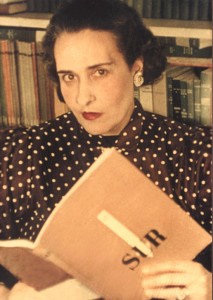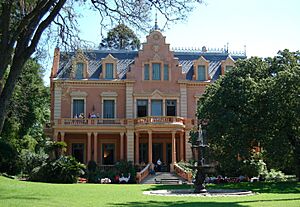Victoria Ocampo facts for kids
Quick facts for kids
Victoria Ocampo
|
|
|---|---|

Ocampo in 1931
|
|
| Born |
Ramona Victoria Epifanía Rufina Ocampo
7 April 1890 Buenos Aires, Argentina
|
| Died | 27 January 1979 (aged 88) Buenos Aires, Argentina
|
| Alma mater | University of Paris |
| Occupation | Writer |
| Relatives | Silvina Ocampo (sister) |
Ramona Victoria Epifanía Rufina Ocampo CBE (April 7, 1890 – January 27, 1979) was an important Argentine writer and thinker. She was well-known for supporting other writers and for publishing a famous literary magazine called Sur. Victoria Ocampo was also a talented writer and critic herself. She was one of the most influential women in South America during her time. Her sister, Silvina Ocampo, was also a writer.
Contents
Victoria Ocampo's Early Life and Education
Victoria Ocampo was born into a wealthy family in Buenos Aires, Argentina. She was taught at home by a French teacher. She once shared that her first alphabet book and the person who taught her to write were both French.
Some people thought she went to the Sorbonne. During a family trip to Paris in 1906–1907, Victoria was allowed to attend some lectures there. She also enjoyed lectures at the Collège de France. However, she never officially enrolled in these universities. Her traditional family believed that women should not have formal education.
In 1912, Victoria married Bernando de Estrada. The marriage was not happy, and they separated in 1920.
Victoria Ocampo's Writing and Publishing Career
In Buenos Aires, Victoria Ocampo was a key figure in the world of writers and thinkers during the 1920s and 1930s. Her first book, written in French, was De Francesca à Beatrice (around 1923). This book was a commentary on Dante's famous work, Divine Comedy.
She wrote many other books, including Domingos en Hyde Park and El Hamlet de Laurence Olivier. She also wrote about famous authors like Emily Brontë and Virginia Woolf. One of her works was a biography of T. E. Lawrence, titled 338171 T.E. (Lawrence of Arabia). She also wrote a series of ten volumes called Testimonios. Her autobiography was published after she passed away. Victoria Ocampo also worked on a book of conversations she had with the famous writer Jorge Luis Borges.
Victoria Ocampo exchanged letters with Virginia Woolf throughout the 1930s. They met several times. Their friendship ended in London in 1939. This happened when Ocampo invited a photographer to take Woolf's picture, and Woolf did not like being photographed.
Even more important than her own writing, Victoria Ocampo founded and published the magazine Sur in 1931. This magazine became the most important literary magazine in Latin America at that time. Many famous writers had their works published in Sur. These writers included Jorge Luis Borges, Ernesto Sabato, Julio Cortázar, Albert Camus, and her own sister, Silvina Ocampo.
Victoria Ocampo's Political Views and Activism
In 1935, Victoria Ocampo met Benito Mussolini in Rome. At first, she admired him, calling him a "genius." However, she was never a strong supporter of fascism. She disagreed with Mussolini's old-fashioned views on women's roles and his country's increasing military actions.
By the time her interview with Mussolini was published in 1936, Italy had invaded another country. Victoria Ocampo added a note to her article. She stated that any hope for the fascist government to improve was gone. She also criticized people in Argentina who supported Italy's aggressive actions.
In 1937, Ocampo and the editors of Sur openly spoke out against fascism. They clearly linked their magazine with liberalism, which supports freedom and equality. During the Spanish Civil War, the magazine supported the Republicans.
Victoria Ocampo also helped edit an anti-Nazi magazine called Les Lettres Francaises from Argentina. In 1946, she was the only Argentine person to attend the Nuremberg Trials. These trials judged important figures from Nazi Germany after World War II. A few months before World War II began in 1939, Ocampo was chosen to be part of the International Committee on Intellectual Cooperation. This committee was part of the League of Nations, an organization that worked for world peace.
In 1953, Victoria Ocampo was briefly put in prison. This happened because she openly opposed the government of Juan Domingo Perón in Argentina.
Later Life and Legacy
In 1976, Victoria Ocampo became a member of the Argentine Academy of Letters. She was the first woman ever allowed into the Academy. She officially took her seat on June 23, 1977.
Her home, Villa Ocampo, in San Isidro, Buenos Aires Province, became a place for important cultural discussions. She had donated the house to UNESCO in 1973. Many famous guests visited Villa Ocampo. These included the composer Igor Stravinsky, the writer André Malraux, and the poet Rabindranath Tagore. Other visitors included Indira Gandhi, José Ortega y Gasset, and Antoine de Saint-Exupéry. The writer Graham Greene dedicated his 1973 novel The Honorary Consul to her.
Victoria Ocampo passed away in Buenos Aires in 1979. She is buried in La Recoleta Cemetery in Buenos Aires.
Honors and Awards
Victoria Ocampo received many honors for her work, including:
- Maria Moors Cabot prize
- Commander of the Order of the British Empire (CBE)
- Doctor honoris causa from Harvard University and Visva-Bharati University
- Premio de Honor de la Sociedad Argentina de Escritores (Honor Prize from the Argentine Society of Writers)
- Gold Medal from the Académie française
Films and Plays About Victoria Ocampo
- Her life was shown in a 1984 TV film called "Four Faces of Victoria." Four actresses played Victoria at different ages.
- A play called Eva and Victoria imagined a meeting between a young Eva Perón and an older Victoria Ocampo. This play was very popular in the 1980s.
See also
 In Spanish: Victoria Ocampo para niños
In Spanish: Victoria Ocampo para niños


